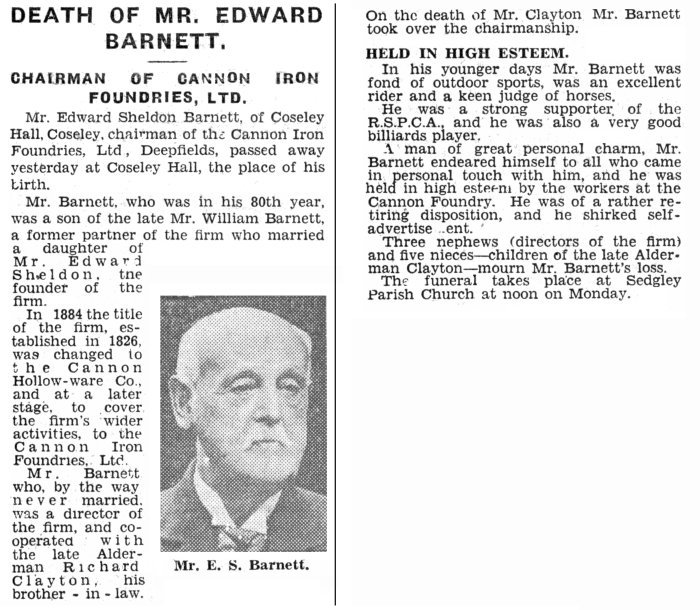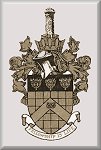|
Into the 20th Century In
1895, Coseley Urban District Council superseded
Coseley Local Board, which had been formed in 1867.
This was a result of the Local Government Act of
1894, which provided legislation for the creation of
urban and rural districts, with elected councils.
The new council had wide powers, particularly in
looking after public health, but many of the
previous functions of the Local Board remained
unchanged. The first Chairman of the new Council was
Richard Clayton, previously Clerk of the Local
Board. The Clerk was Joseph
Smith.
Other members:
Rev. Henry
Eachus
Job
Edward East
William Hampton
William Hawkins
Samuel
Jackson
Edward
Jordon |
James Lamb
Charles Lathe
William
Mobberley
George M.
Morgan
George Ray
William Henry Robinson
John Shorthouse |
Frederick
Slater
William Smout
Joseph Taft
John Walters
JosiahWhitehouse
Edward Wones |
|
Thomas
Gilbert -
Treasurer
Joseph George Clendinnen
-
Medical Officer of
Health
Charles William
Shackleton -
Surveyor
John
Mills -
Sanitary Inspector &
Inspector of Canal Boats
& Dairies
Albert J.
Sherwin -
Collector |
|
|
The majority of the councillors had previously been
officers of the Local Board. There was also a County
Police Station, in Avenue Road, with Sergeant Henry
R. Ward
and 4 constables. Under the terms of the Act,
Richard Clayton also became a Justice of the Peace
for Staffordshire and in 1904, an Alderman of the
county. Permanent Council
offices were opened in 1896 with the building of the
Council House, which was on the corner of School
Street and Green Street. The building contained a
Council Chamber, Committee Rooms, administration
offices and a mortuary. A fire station, an ambulance
station, highway maintenance buildings and a health
clinic were added later. Coseley still remained part
of the ancient Poor Law parish of Sedgley, until
1902, when two separate Poor Law parishes were
formed. The Council House survived until around
1970, when it was demolished.
Richard Clayton was Chairman
and Managing Director of Cannon Iron Foundries and
lived in Coseley Hall. He was born at Ingwardine
Hall, Shropshire in 1846. In 1874, he married Fanny
Eliza Barnett, the granddaughter of Edward Sheldon,
founder of Cannon Iron Foundries. He became a
partner in the firm in about 1878. Richard died in
1915 and Coseley Hall and the estate were sold in
1930 after Fanny Clayton’s death. The sale included
a large piece of land on the opposite side of the
railway line, which became Clayton Park.
|

From the
Express & Star, 12th October, 1929. |
| On the 4th April, 1930, Coseley Hall
and estate was sold at Auction at the
Victoria Hotel, Wolverhampton. The hall
sold for £2,500. The contents were
auctioned on the 8th, 9th, and 10th of
April. |
| Sheldons Terrace, numbered 1 to 4
consisted of four houses, each with two
living rooms and two bedrooms. Number 1
was occupied by the gardener. Number 6
had one living room and one bedroom and
numbers 7 to 13, and 15, 16 had one
living room and two bedrooms, number 14
had four bedrooms. Numbers 5 to 7
Fullwoods End had one living room, two
bedrooms and a paved yard.
There was also a 7 stall stable with
a yard in Sheldons Terrace.
The hall is described as a fine old
residence with useful outbuildings in
delightful grounds. The residence has
two and three storeys and is of brick
and slate construction, approached from
the railway station end by a gravelled
drive. |

The map from the
sale catalogue. |
| On the ground floor was a portico, a
spacious entrance hall, a tiled cloak
room, toilets, a dining room, a drawing
room, a breakfast room, a business room,
a library, a butler's pantry, a kitchen,
a china pantry, a coal house and a back
hall with a tradesman's entrance. On the
first and second floors were 14
bedrooms, a billiards or dance room, two
offices, a boot room and a harness or
saddle room. The outbuildings included a
two-stall stable, a coach house, a
garage for three cars, a wash house,
three iron water tanks and two pigstyes. |

Caddick Street and the Coppice
Chapel.
In 1902, as a result of the
Education Act of 1902, the School Board was
dissolved and the Urban District Council became the
local elementary education authority. Under the
terms of the Act, it became a Part III Authority,
because the local population was over 20,000. It
retained this status until the passing of the 1944
Education Act.
In 1912, Coseley was divided
into five Wards as a result of a County Council
Order, made on the 6th June. The Wards were West
Central, Hurst Hill, Spring Vale, South East and
Highfields.
In 1913, Coseley acquired its
first cinema, called the ‘Coseley Picture House’,
which was at the junction of Ivyhouse Lane and
Providence Row. It was run by William Page, a
cabinet-maker, who lived across the road from the
cinema and a Mr. Cook. They acquired planning
permission for the cinema in December 1912 and
building work soon got underway. The cinema finally
opened for business in the spring of 1913 after
having to make a few adjustments before the council
would grant a licence.
It became known as Page’s.
William died in the mid 1930s and his son, William
John Page took over the running of the cinema.
Initially the front row seats were bare benches,
which were later upholstered. The seats behind were
proper tip-up seats, installed in the 1930s. The
cinema could then seat 450 people. Mr. Cox, a local
painter and decorator provided piano accompaniment
and children’s matinees were held on Tuesdays and
Saturdays. Sound equipment was installed in the
early 1930s. |
|

The old Cosy Cinema building as it
is today. |
In about 1950, the cinema was bought by Mr. L. Wilde and
Mr. L. Poole and renamed ‘The Cosey Cinema’.
Cinema audiences were in decline and the new owners were
unable to keep-up with their mortgage repayments.
The cinema closed in 1957 and in 1961 it became Coseley
Ex-Servicemen’s Club. |
|
A large number of young men
from Coseley, joined-up to fight in the First World
War. Patriotism was rife, and people thought it
would be a short war, lasting until Christmas. Sadly
of course, this was not the case and many of the
recruits never returned home. Coseley itself saw no
action other than a nearby zeppelin raid in January
1916, which resulted in many deaths in Tipton,
Wednesbury and Walsall, and a young couple who were
walking beside the old main line canal at Bradley.
At the end of the war, the
council’s housing schemes began. Between 1919 and
1922, over 200 houses were built at several
locations including Old End, Upper Ettingshall and
Princes End. In 1924, a further 600 houses were
built over a period of 9 years. Other schemes
followed in 1930 and 1936. Council estates were also
built at Ward Grove, Lanesfield; Hartland Avenue,
Hurst Hill; Norton Crescent, Wallbrook and the
Batmanshill Road estate near Princes End.

The Woodcross Council Estate.
Another important event in 1924
was the start of the sewage disposal plan, which led
to the building of sewers throughout the district
and the opening of the sewage disposal works at the
Foxyards. This had previously been impossible
because of the vast coal and iron industries that
once covered much of the area.
In 1926, The Hadow Report on
‘The Education of the Adolescent’ resulted in the
reorganisation of elementary education. All-age
schools were abandoned in favour of separate schools
from the age of 11, which became known as secondary
modern schools. Many new schools had to built
throughout the country, including Manor School at
Coseley, in 1933.
In 1927, much of the western
side of Coseley began to change as a result of the
building of the Birmingham New Road, which also
greatly helped local businesses. The building of the
ten mile- long trunk road from Wolverhampton to
Birmingham, had been suggested much earlier but the
large cost of such an enterprise could not be met by
the local authorities. The project became a reality
when the Ministry of Transport offered to provide
half the cost, which was later increased to sixty
percent. Work began in 1924. It was carried out by
Sir Robert McAlpine and Sons, and involved the
building of many embankments and cuttings and the
stabilisation of a large number of old mine shafts.
At Roseville, a number of houses had to be
demolished. The project cost £600,000 and the road
was officially opened on the 2nd November, 1927 by
Edward Prince of Wales.
An avenue of trees was planted
alongside the road to commemorate the servicemen who
were killed in the First World War. Each tree was
surrounded by a metal frame with a plaque bearing
the name of one of the dead. The road greatly
benefited local industries. Some new industries
opened in Coseley and others greatly expanded. New
shops eventually opened in the area and the Silver
Jubilee Park was built alongside the road, on the
site of several coal mines. The land was purchased
from the Earl of Dudley in December 1930. The park
was named after the silver jubilee of King George V
and officially opened on the 28th May, 1936.
Councillor Grange, Chairman of the Parks and Open
Spaces Committee, officially opened the park. Also
present was Councillor Greenshill, Chairman of the
Coseley Urban District Council. |
|

The Square
in Roseville. From an old postcard. |
 |
In 1939, Coseley acquired a new cinema, in
the form of the Clifton, which stood on the
corner of Castle Street and Mason Street, where
the shops are today. It officially opened on
Saturday, the 8th July, 1939, with a showing of
Ralph Richardson in “South Riding” and Will Hay
in “Oh Mr. Porter”. It seated 724 people in the
stalls and 280 in the circle. |
|
For many
years the Clifton was very successful, but in 1963 it closed
because of the decline in cinema audiences. The last film, starring Juliet Mills in “Nurse
on Wheels”, was shown on the 10th August 1963. By
the end of the year the cinema had been demolished
and work started on the row of shops.

St. Chad's Church and Coseley
windmill.
The onset of the Second World
War in 1939, saw the introduction of conscription
for all able-bodied men between the ages of 18 and
41, unless they were working in a reserved
occupation. They would receive their call-up papers
in the post, which included details of where and
when they had to attend a medical, and begin
military training. In 1941, conscription was
introduced for unmarried women between the ages of
20 and 30. They were not expected to take part in
the fighting, but had to work in one of the reserved
occupations, especially in factories and farming.
They also worked as air raid wardens, and joined the
ATS (the army’s Auxiliary Territorial Service), in
which they acted as drivers, worked in mess halls,
or worked on anti-aircraft guns, but were not
actually allowed to fire them. Some also became
welders, carpenters, and electricians. By July 1942
there were 217,000 women in the ATS.
Coseley got off very lightly in
the war, considering the number of large factories
in the area that could have been targeted by German
bombers. Stewarts and Lloyds steelworks at Bilston
was a target in the night-time bombing raids, and in
one such raid, on the 30th August, 1940, a bomb
missed its target and damaged the Horse and Jockey
pub in Ivyhouse Lane. Other bombs fell on houses in
Ward Street and a landmine fell on boggy ground in
Bradleys Lane, but luckily there were no fatalities.
Sadly some of the conscripts never returned home. |
 |
|
 |
|
 |
Return to
Pubs |
|
Return to
the
Contents |
|
Proceed to
Recent Times |
|